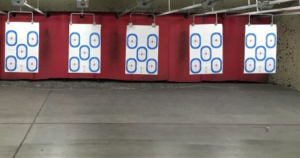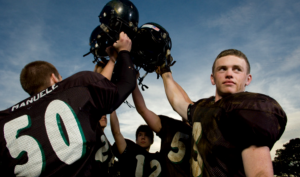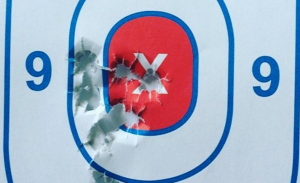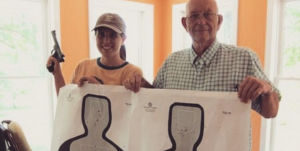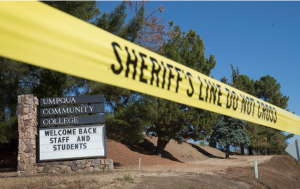When I was in college, I was invited over to a guy’s apartment for a home cooked meal. Once I got to his apartment located near the University of Tennessee, I smelled the aroma of chicken wafting through the room and heard my favorite CD.
But, it was a trap.
When I wrote, “5 reasons why I decided to take my gun carry permit class… and carry this time for real,” I listed many of the reasons why I wanted to protect myself. But I didn’t mention the sense of unease I’ve carried since that moment so many years ago. Though I considered myself pretty strong, he overpowered me with embarrassingly little effort. No matter how many movies Hollywood makes with the petite woman antagonist who somehow manages to fight like a guy, there would be no fighting, hitting, kicking, or scratching my way out of that night. When his hand went around my neck, I was so surprised and baffled I’m not even sure I tried to scream.
In a previous class, Agape Tactical’s founder Ken Alexandrow (wearing a bright orange UT shirt, naturally) stopped by to deliver a few words of advice. “Any woman who has survived an attack did the right thing… I know that because she’s still here.”
But I didn’t do anything right. I’d walked into an unsafe environment. I was hundreds of miles from home. I had no way to defend myself.
I’m going to die tonight. That was what was going through my head as he slammed it against the wall and the corner of the coffee table. In fact, one of the blows shattered the coffee table’s glass insert. That’s what saved me — not any heroic act on my part. There were five guys outside his apartment who heard the furniture breaking inside and looked through a slit in the curtains. When they saw what was happening, they broke down the door and took care of my attacker rather quickly.
I often think about that night: how wrong I was to have gotten into that situation, how thankful I am that I lived through the attack, and how baffled I was that I didn’t really fight back.
Since then, I’ve learned a bit more about the way people respond to scary events. You’ve probably heard of “fight or flight?” Well, there’s a third response called “freeze.” The characteristics of a “freeze response” are:
- Feeling stuck in some part of [your] body
- Feeling cold/frozen, numb, pale skin
- Sense of stiffness, heaviness
- Holding breath/restricted breathing
- Sense of dread, heart pounding
- Decreased heart rate
Fast forward several years. I’ve been married for twenty years to a great man: we have three kids, two dogs, and seven chickens in a relatively peaceful rural Tennessee life. Rarely am I ever in a truly scary situation, but some threats I received caused me to put some effort into learning how to carry a weapon. So far, I’d taken my gun carry permit class, beginner’s pistol, and intermediate pistol. Saturday was Tactical 1 Training, a five-hour class which took place under a relentless 95 degree sun on an outdoor range in the rolling hills of Tennessee. For the first time, since beginning my “Warrior Woman” class schedule, I didn’t have pressing anxiety about being near firearms. I was looking forward to it.
One of the Agape instructors there that day was named Brandon, an Operation Iraqi Freedom II veteran with sleeves of tattoos and a speaking manner that somehow combined General Patton, Sun Tzu, and Dr. Phil.
“Today you will do what others won’t,” he said, paraphrasing former San Francisco 49ers Jerry Rice. “So tomorrow you will accomplish what others can’t.” He stood in front of us and reviewed what I’d learned in previous classes: stance, grip, draw stroke, and quick target acquisition.
“Live in the now,” he said. That was how he encouraged us not to peek over our sights to check out the target. He explained that when we look at the holes in the target, we’re living in the past. There’s nothing we can do to change how we’ve shot in the past, we can only change how we shoot now and in the future. Several of the other class members were veterans who’d been deployed with Brandon. Though it was intimidating to be on the range with actual Marines, it was touching to see their affectionate camaraderie.
I’m a mother of three with a borrowed Glock 19, I thought. I can do this. A few weeks ago, I’d begun introducing my 8 year old to Little House on the Prairie. In fact, I’d watched the episode when Laura goes up into a mountain to pray and meets God… who just so happens to be Ernest Borgnine.
Well, the target we were using that day looked like Ernest Borgnine-in-need-of-manscaping:
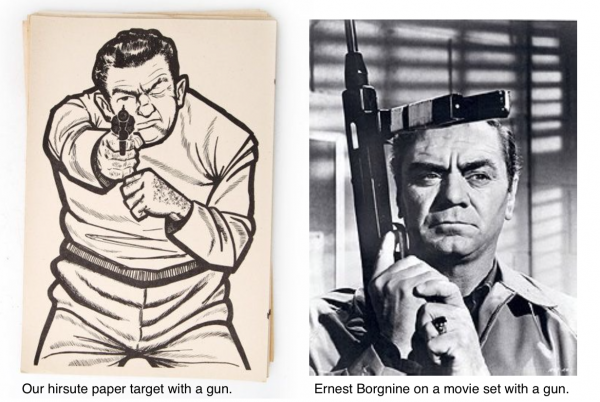
Saturday, we learned one-on-one combat tactics, proper body mechanics/instinctive shooting, speed reloading, malfunction clearing, one handed shooting, and shooting while moving. In one drill, we placed that paper man about three feet in front of us, as instructors tried their best to simulate a “stressful environment.” Dawn came up behind me and put her arm around my chest and neck area while jacking my left arm behind my back. I managed to get two shots off into the “pelvic girdle” of the target.
Bang! bang!
When Ken, however, did the same thing, I froze. With his arms around my chest, I felt like I was sinking or drowning. I couldn’t pull the trigger. He was saying something to me, but I couldn’t make out the words. I felt like I suddenly could only see “Borgnine’s” paper gun aiming squarely at me, not even Dawn who was giving me instructions from one foot away.
When I finally managed to pull the trigger, I shot low. Tried again. Gun malfunction. Ken gave me some time, and we repeated the same drill — with Dawn again and then another instructor named Jason. Again, I was able to shoot with Dawn’s arm around my neck, but was paralyzed when the male instructors repeated the same drill. (“I’m going to pull your arm behind you,”Jason said after sensing my anxiety. “I’m just the father of four children.”)
“You will never rise to the occasion,” Ken is fond of saying. “In a traumatic situation, you will sink to your lowest level of competent training.” On that sweltering day, I sank. I was not “myself” for quite some time – my hands were shaky, I couldn’t quite concentrate on the instructions or even really hear them. At one point, we were doing a drill in which we needed ammunition in the chamber, one in the magazine. We’d take two shots, then reload quickly by pulling a new magazine out of our mag pouch and reloading without having to manipulate the magazine. Ken stood beside me and calmly helped when I was trying to set this scenario back up. I held a full magazine, a partial magazine, some bullets I’d gotten from my pocket, and an empty gun. Though I’d done this drill just a week ago, I couldn’t figure out where anything went.
“Live in the now.”
I heard Brandon barking out these instructions about twenty feet away as he described our upcoming shooting contest. He was probably warning the students not to evaluate their shots by looking at their targets, but the words somehow managed to penetrate my mental fog.
I finished the class.
Afterwards, Dawn — who’s a licensed minister — switched effortlessly from a pep talk to the kind of kick-butt spiritual advice you’d never hear in church. She explained that Agape does these simulations so that, in a moment of stress, students will have trained for such a moment. She explained that people in stress do experience “auditory exclusion,” which is why I couldn’t hear what Ken was saying to me. People also experience a reduction in fine motor skills and tunnel vision.
“When you’re in a frightful situation,” Dawn has said repeatedly, “You’re at best 30% of your non-stressed 100% self.”
I was embarrassed that my “frightful situation” was so slight, when I was shooting with war veterans.
“Where did you serve?” I asked Brandon as I was heading to my car. He darted off a list of places he had been both during his military service and as a contractor — none would’ve made it onto your vacation “bucket list.” I stood there in awe of what he (and his friends) had presumably been through during the war. I wanted to convey my appreciation for all he and his friends had done for our nation, for being tough-as-nails and teaching others to try to be tough too, for standing tall and refusing to cower before the evil he’d undoubtedly seen.
But all I managed to say was “thanks for doing that” — like he was a waiter who had refilled my glass of ice tea.
I felt ridiculous. I felt embarrassed. But I also felt incredibly grateful to be living in a nation where we can own guns and learn to protect ourselves. No, I’ll never be as tough as those Marines.
But we normal-Americans owe it to them to take advantage of the freedom they’ve guaranteed us by not becoming a weak bunch in need of trigger-warnings, coddling, and safe spaces.
I’m honestly not sure how to do that, but I feel like making it through this class was a start.
READ THE COMPLETE SERIES:
5 reasons why I decided to take my gun carry permit class… and carry this time for real
4 things I learned in my “women only” beginner pistol class
The most important, life-saving advice I learned during my Intermediate Pistol Class

